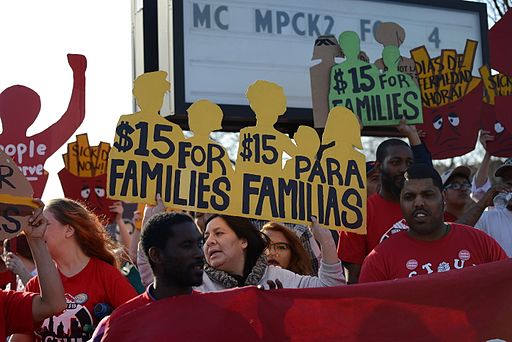Squish Like Grape
You are here
Are Minimum Wage Jobs Meant for Teenagers?
Primary tabs
Two million American workers will be seeing bigger paychecks after their states voted in November to raise the minimum wage. By 2020 the minimum hourly wage is scheduled to go up to $12 per hour in Arizona, Colorado, and Maine, and $13.50 in Washington.
But some people are still not satisfied. Bernie Sanders, for example, campaigned on a national minimum wage of $15 per hour. That's more than twice the current national level of $7.25, and though Sanders has found a lot of supporters, he has also gotten a lot of pushback.
Wage economics is a complex problem, and it's no simple task to determine the relationship between wages and the employment rate. I'm certainly not going to solve that problem in a blog post.
But from some quarters, the opposition to a minimum wage increase has taken a bizarre turn, arguing that adults shouldn't be working minimum wage jobs in the first place. Those jobs, the argument goes, are meant for teenagers who want to make a little extra money after school.
This is simply revisionist history. When Franklin Delano Roosevelt announced the first minimum wage as part of his National Industrial Recovery Act of 1933, he was quite clear about the meaning and purpose of the minimum wage.
In my Inaugural I laid down the simple proposition that nobody is going to starve in this country. It seems to me to be equally plain that no business which depends for existence on paying less than living wages to its workers has any right to continue in this country. By "business" I mean the whole of commerce as well as the whole of industry; by workers I mean all workers, the white collar class as well as the men in overalls; and by living wages I mean more than a bare subsistence level-I mean the wages of decent living.
There can be no doubt he was talking about full-time wage earners with families to support.
Now, one could make the case that the labor force has changed since 1933. Technology has forced workers to learn new skills, and there are very few jobs left at the very bottom. That's a fair criticism. The Bureau of Labor Statistics estimates about 3.5 million Americans make $7.25 or less per hour, out of a workforce of about 150 million. That's a little over two percent.
But while $7.25 per hour might provide decent pocket change for a teenager, it won't let a single parent feed a family of four. If the minimum wage is intended to be a living wage—enough to put a family above, and not simply at the poverty line—$15 might be barely enough.
And if the minimum wage were raised to $15, it would cover a lot more jobs. Some 42% of the workforce make less than $15 per hour, or about 63 million workers. That includes—in addition to restaurant and retail workers—many hospital workers, farm workers, truckers, casino workers, home health aides, housekeepers, and airport workers.
Now if you're wondering where we can possibly find enough teenagers to staff all those jobs, you're not alone. The census bureau estimates a little less than 42 million American children between the ages of 10 and 19. That would cover only about 2/3 of the jobs. To fill all the openings we'd need everyone between the ages of 10 and 24.
But kids below 14 can't legally work, so we'll have to adjust the range. We'll need everyone between 14 and 28 to work full time to cover all the minimum wage jobs. But this is unrealistic as well. Kids below 16 can't work full time—they're limited to 18 hours a week during the school year—and kids between 16 and graduation may not have the time or the inclination to spend their evenings pushing a broom or sleeping in a truck cab. Let's estimate that everyone over age 21 works full time; half of all the kids between 16 and 21 choose to work full time, and half the kids work half time, 20 hours a week; and half the kids age 14 and 15 work half time, and half do not work at all. This probably greatly overstates the potential labor pool, but it simplifies the math. The number of hours lost in this scenario requires us to add three more years of recent graduates to the pool. So now we've got everyone age 31 and under filling $15/hour jobs (or under today's wage laws, below $15), so that we don't have to give those jobs to adults. But many of these "kids" would be long out of school, and would be considered full adults by any measure.
After we account for those who choose to start their own businesses, or who are able to get better paying jobs straight out of college, or who choose family over career or otherwise don't participate in the labor force, we're going to need people well into their 30s (and maybe 40s) filling minimum wage jobs.
The main problem is not that these adults don't want better pay; the problem is that these jobs need to be filled. You can't eliminate retail workers and city sanitation workers and farm workers and restaurant staff and cab drivers and home health aides and office cleaning staff and over-the-road truckers—or give all these jobs to teens—and still have a functioning society.
Trying to limit low-paying jobs to teenagers does not solve the problem, and in fact creates a bigger one. The only way to find enough kids to fill them would be to slash the child labor laws to allow—or more likely, to require—teens and even preteens to work full time. Such a scenario takes us far from FDR's lofty goals and closer to the era memorialized in Sarah Cleghorn's famous poem.
The golf links lie so near the mill
That almost every day
The laboring children can look out
And see the men at play.
That's not the way to make America great again. Let's raise the minimum wage.
Theme by Danetsoft and Danang Probo Sayekti inspired by Maksimer



